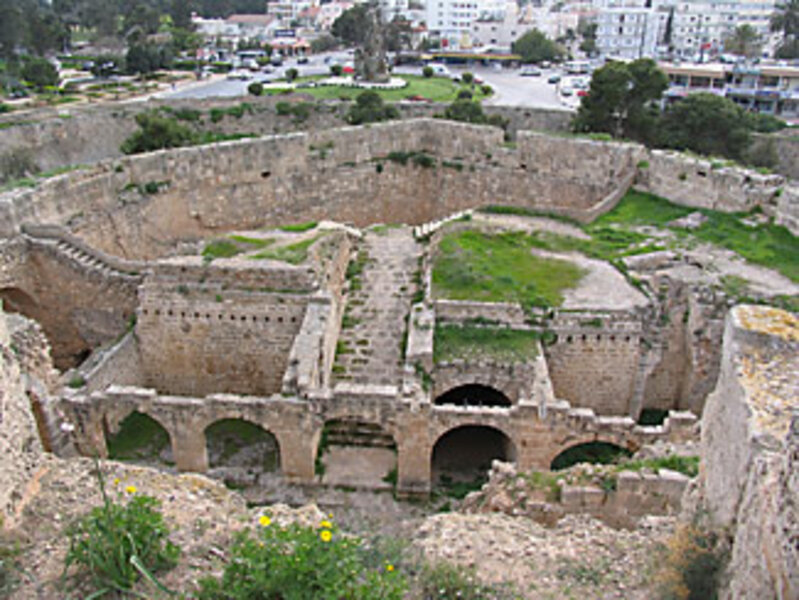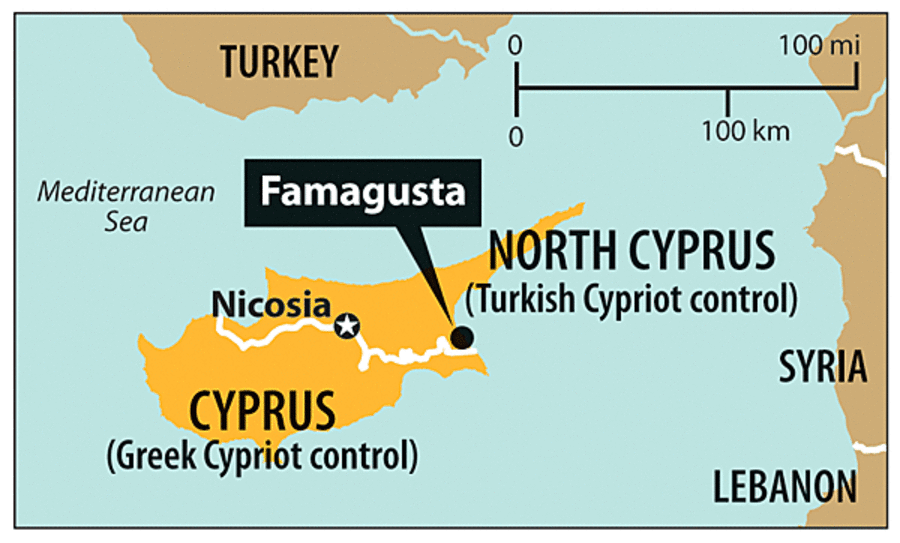Divided Cypriots unite to preserve ancient Famagusta
Loading...
| Famagusta, Cyprus
In its pulsating 14th-century heyday, this walled port was the region's richest city. Home to rich merchants and bejewelled courtesans, Famagusta's streets and markets echoed with Greek, Arabic, French, Hebrew – even Tamil and Norse.
The fabled setting for Shakespeare's Othello, it was also the seat for Jerusalem's exiled French Crusader kings. Later ruled by Italians and then conquered by the Ottomans, it testifies to a storied past. Within a few blocks stand a French Gothic cathedral, an Italian Renaissance palace, a Byzantine church, and an Ottoman madrassah-turned-restaurant.
"You have 2,000 years of historical architecture within reaching range. It's astonishing," says Allan Langdale, a Canadian art historian who recently made a documentary about Famagusta's beauty and plight.
Now, in a rare bicommunal project, the city's estranged Greek and Turkish Cypriot communities are uniting to preserve the ancient walled city's architectural treasures. So far, such efforts have been frozen by the politics of a divided Cyprus and a lack of funding.
Supporters hope the cooperative nature of the project will help overcome political hurdles, opening legal channels for foreign funding. In turn, they say, the project could boost reunification efforts for Cyprus by building confidence. In a symbolic step toward reunification, the crossing point on Nicosia's Ledra Street was to be opened Thursday.
"The people of Famagusta, Greek and Turkish Cypriots ... should join forces not only to save the past, but to build a future in a reunited Cyprus and Famagusta," Alexis Ghalanos, representative of Famagusta's displaced Greek Cypriot community, said at a meeting that launched the project in December.
"The value Famagusta holds for world heritage is greater than all those things that have separated us for so long," he added. "I sincerely hope that this [initiative] can prove a steppingstone to the opening of the city to Europe and to Cyprus as a whole."
Oktay Kayalp, Famagusta's Turkish Cypriot representative, agreed that a common front is needed to help the city that he sees as a historic bridge between East and West, Christianity and Islam.
The political atmosphere was transformed following February polls, when Greek Cypriots rejected their hard-line president and voted in moderate President Demetris Christofias. For the first time in decades, both sides have conciliatory leaders determined to restart peace talks that collapsed four years ago.
Famagusta lies on the internationally unrecognized, Turkish-controlled northern half of the island, which foreign experts say lacks money and expertise to preserve the monuments. Greek Cypriots, who head the island's internationally recognized government, generally frown at unsanctioned intervention in antiquities in northern Cyprus, which they do not have access to. For more than three decades, none of Famagusta's 45,000 former Greek Cypriot residents have enjoyed access to their homes in new Famagusta, a fenced-off ghost town known as Varosha.
Cyprus has been split along ethnic lines since 1974, when Turkey invaded the north in response to a Greek Cypriot coup engineered by the military junta then ruling Greece. Some 180,000 Greek Cypriots and 50,000 Turkish Cypriots were displaced.
The UN and world heritage groups are enthusiastic about preserving Famagusta's history. "It's a very important city to Western European history," says Costa Carras, a vice president of Europa Nostra, a Pan-European heritage foundation. "It will be an absolutely wonderful project for the EU and the EU ideal, because it will show culture can help bring people together."
Europa Nostra is chairing a conference April 4 in Paris at which Greek and Turkish representatives of Famagusta will address European parliamentarians and UNESCO officials about the need to preserve Famagusta's endangered architectural heritage. "The Stones of Famagusta," Mr. Langdale's film, will be screened. Eighteen international academics will then hold a two-day scientific workshop on the walled city. This event, supported by Mr. Ghalanos and Mr. Kayalp, will have a touch of historical romance thanks to the presence of a French descendant of the dynasty that ruled Cyprus during Famagusta's peak: the resplendently named Prince Philippe Roux de Lusignan.
Famagusta was a minor port until the First Crusade was launched in 1095 to wrest the Holy Land from Muslim control. Just 100 miles from the Syrian coast, it gained strategic importance. Its preeminence was sealed in 1291, when the Crusaders lost Acre, their last Holy Land outpost.
Christian refugees, merchants, and traders from the region flocked to Famagusta, transforming it into a key emporium for trade between Europe and the East.
The island was ruled by the Lusignans, an eccentric dynasty of French Crusader nobles, for three turbulent centuries until the Venetians took control in 1489. In 1571, after a 10-month siege, the 200,000-strong Ottoman Army captured Famagusta, expelling its Greek Cypriot inhabitants, who have never since lived within the old walled city. Ottoman rule ended in the late 19th century when Britain took over.
Langdale says there is no finer Medieval and Renaissance walled city, with the possible exception of Dubrovnik, Croatia. In "Journey Into Cyprus," the celebrated travel writer, Colin Thubron, enthused: "Nothing could be stranger for a lover of architecture than to walk through so many Medieval ages together."
Famagusta's honey-colored Venetian-era stone walls, nearly two miles long, are still intact, ranking among the world's finest examples of Renaissance military architecture. But no serious conservation has been done since independence in 1960. Some of the 150,000 cannonballs fired by the Ottomans at and over the Venetian-era stone ramparts remain visibly embedded in church walls. War was followed by centuries of neglect and weathering. The French Gothic cathedral of St. Nicholas, which Ottomans turned into a mosque, shows signs of erosion.
There is "real structural concern [for many of the city's monuments]," Langdale says. Chunks of floriated stonework, carved in medieval times, lie scattered around churches, while empty cans and pigeon droppings litter once-magnificent buildings.
Langdale points out a fragment of stone tracery that tumbled from a half-ruined 14th-century Carmelite Church since he last visited it only two months ago. "The neglect is amazing," he says.






